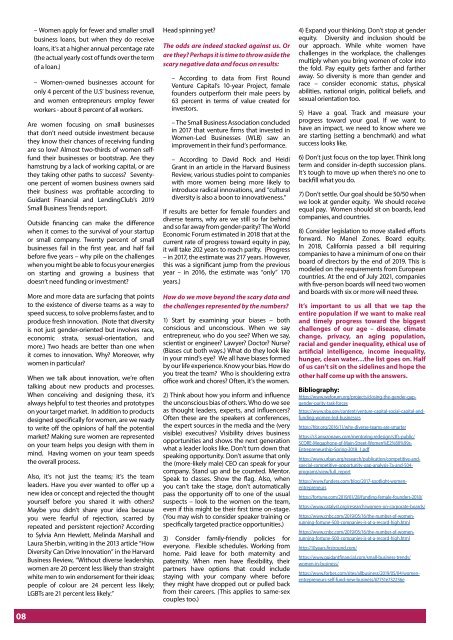The Women's IP World Annual 2019/2020
We are delighted to present you with the launch edition of The Women’s IP World Annual 2019/2020, celebrating women at all levels working in IP Law and Innovation. From the very beginning, the response and feedback we had was amazing, and we would like to thank all of the incredible women involved. Our aim was to celebrate a group of diverse women, from all over the globe, showcasing their achievements and also their personalities to inspire and inform. We have taken an unbiased approach and kept the articles & profiles as authentic as possible, to keep the author's own personal style. This has resulted in a cocktail of inspirational women coming together to share thoughts, ideas, and experience positively. We hope you enjoy this issue as much as we have enjoyed putting it together. Ms. Elvin Hassan Editor & Head of International liaisons
We are delighted to present you with the launch edition of The Women’s IP World Annual 2019/2020, celebrating women at all levels working in IP Law and Innovation. From the very beginning, the response and feedback we had was amazing, and we would like to thank all of the incredible women involved. Our aim was to celebrate a group of diverse women, from all over the globe, showcasing their achievements and also their personalities to inspire and inform. We have taken an unbiased approach and kept the articles & profiles as authentic as possible, to keep the author's own personal style. This has resulted in a cocktail of inspirational women coming together to share thoughts, ideas, and experience positively. We hope you enjoy this issue as much as we have enjoyed putting it together.
Ms. Elvin Hassan
Editor & Head of International liaisons
Create successful ePaper yourself
Turn your PDF publications into a flip-book with our unique Google optimized e-Paper software.
– Women apply for fewer and smaller small<br />
business loans, but when they do receive<br />
loans, it’s at a higher annual percentage rate<br />
(the actual yearly cost of funds over the term<br />
of a loan.)<br />
– Women-owned businesses account for<br />
only 4 percent of the U.S’ business revenue,<br />
and women entrepreneurs employ fewer<br />
workers - about 8 percent of all workers.<br />
Are women focusing on small businesses<br />
that don’t need outside investment because<br />
they know their chances of receiving funding<br />
are so low? Almost two-thirds of women selffund<br />
their businesses or bootstrap. Are they<br />
hamstrung by a lack of working capital, or are<br />
they taking other paths to success? Seventyone<br />
percent of women business owners said<br />
their business was profitable according to<br />
Guidant Financial and LendingClub’s <strong>2019</strong><br />
Small Business Trends report.<br />
Outside financing can make the difference<br />
when it comes to the survival of your startup<br />
or small company. Twenty percent of small<br />
businesses fail in the first year, and half fail<br />
before five years – why pile on the challenges<br />
when you might be able to focus your energies<br />
on starting and growing a business that<br />
doesn’t need funding or investment?<br />
More and more data are surfacing that points<br />
to the existence of diverse teams as a way to<br />
speed success, to solve problems faster, and to<br />
produce fresh innovation. (Note that diversity<br />
is not just gender-oriented but involves race,<br />
economic strata, sexual-orientation, and<br />
more.) Two heads are better than one when<br />
it comes to innovation. Why? Moreover, why<br />
women in particular?<br />
When we talk about innovation, we’re often<br />
talking about new products and processes.<br />
When conceiving and designing these, it’s<br />
always helpful to test theories and prototypes<br />
on your target market. In addition to products<br />
designed specifically for women, are we ready<br />
to write off the opinions of half the potential<br />
market? Making sure women are represented<br />
on your team helps you design with them in<br />
mind. Having women on your team speeds<br />
the overall process.<br />
Also, it’s not just the teams; it’s the team<br />
leaders. Have you ever wanted to offer up a<br />
new idea or concept and rejected the thought<br />
yourself before you shared it with others?<br />
Maybe you didn’t share your idea because<br />
you were fearful of rejection, scarred by<br />
repeated and persistent rejection? According<br />
to Sylvia Ann Hewlett, Melinda Marshall and<br />
Laura Sherbin, writing in the 2013 article “How<br />
Diversity Can Drive Innovation” in the Harvard<br />
Business Review, “Without diverse leadership,<br />
women are 20 percent less likely than straight<br />
white men to win endorsement for their ideas;<br />
people of colour are 24 percent less likely;<br />
LGBTs are 21 percent less likely.”<br />
Head spinning yet?<br />
<strong>The</strong> odds are indeed stacked against us. Or<br />
are they? Perhaps it is time to throw aside the<br />
scary negative data and focus on results:<br />
– According to data from First Round<br />
Venture Capital’s 10-year Project, female<br />
founders outperform their male peers by<br />
63 percent in terms of value created for<br />
investors.<br />
– <strong>The</strong> Small Business Association concluded<br />
in 2017 that venture firms that invested in<br />
Women-Led Businesses (WLB) saw an<br />
improvement in their fund’s performance.<br />
– According to David Rock and Heidi<br />
Grant in an article in the Harvard Business<br />
Review, various studies point to companies<br />
with more women being more likely to<br />
introduce radical innovations, and “cultural<br />
diversity is also a boon to innovativeness.”<br />
If results are better for female founders and<br />
diverse teams, why are we still so far behind<br />
and so far away from gender-parity? <strong>The</strong> <strong>World</strong><br />
Economic Forum estimated in 2018 that at the<br />
current rate of progress toward equity in pay,<br />
it will take 202 years to reach parity. (Progress<br />
– in 2017, the estimate was 217 years. However,<br />
this was a significant jump from the previous<br />
year – in 2016, the estimate was “only” 170<br />
years.)<br />
How do we move beyond the scary data and<br />
the challenges represented by the numbers?<br />
1) Start by examining your biases – both<br />
conscious and unconscious. When we say<br />
entrepreneur, who do you see? When we say,<br />
scientist or engineer? Lawyer? Doctor? Nurse?<br />
(Biases cut both ways.) What do they look like<br />
in your mind’s eye? We all have biases formed<br />
by our life experience. Know your bias. How do<br />
you treat the team? Who is shouldering extra<br />
office work and chores? Often, it’s the women.<br />
2) Think about how you inform and influence<br />
the unconscious bias of others. Who do we see<br />
as thought leaders, experts, and influencers?<br />
Often these are the speakers at conferences,<br />
the expert sources in the media and the (very<br />
visible) executives? Visibility drives business<br />
opportunities and shows the next generation<br />
what a leader looks like. Don’t turn down that<br />
speaking opportunity. Don’t assume that only<br />
the (more-likely male) CEO can speak for your<br />
company. Stand up and be counted. Mentor.<br />
Speak to classes. Show the flag. Also, when<br />
you can’t take the stage, don’t automatically<br />
pass the opportunity off to one of the usual<br />
suspects – look to the women on the team,<br />
even if this might be their first time on-stage.<br />
(You may wish to consider speaker training or<br />
specifically targeted practice opportunities.)<br />
3) Consider family-friendly policies for<br />
everyone. Flexible schedules. Working from<br />
home. Paid leave for both maternity and<br />
paternity. When men have flexibility, their<br />
partners have options that could include<br />
staying with your company where before<br />
they might have dropped out or pulled back<br />
from their careers. (This applies to same-sex<br />
couples too.)<br />
4) Expand your thinking. Don’t stop at gender<br />
equity. Diversity and inclusion should be<br />
our approach. While white women have<br />
challenges in the workplace, the challenges<br />
multiply when you bring women of color into<br />
the fold. Pay equity gets farther and farther<br />
away. So diversity is more than gender and<br />
race – consider economic status, physical<br />
abilities, national origin, political beliefs, and<br />
sexual orientation too.<br />
5) Have a goal. Track and measure your<br />
progress toward your goal. If we want to<br />
have an impact, we need to know where we<br />
are starting (setting a benchmark) and what<br />
success looks like.<br />
6) Don’t just focus on the top layer. Think long<br />
term and consider in-depth succession plans.<br />
It’s tough to move up when there’s no one to<br />
backfill what you do.<br />
7) Don’t settle. Our goal should be 50/50 when<br />
we look at gender equity. We should receive<br />
equal pay. Women should sit on boards, lead<br />
companies, and countries.<br />
8) Consider legislation to move stalled efforts<br />
forward. No Manel Zones. Board equity.<br />
In 2018, California passed a bill requiring<br />
companies to have a minimum of one on their<br />
board of directors by the end of <strong>2019</strong>. This is<br />
modeled on the requirements from European<br />
countries. At the end of July 2021, companies<br />
with five-person boards will need two women<br />
and boards with six or more will need three.<br />
It’s important to us all that we tap the<br />
entire population if we want to make real<br />
and timely progress toward the biggest<br />
challenges of our age – disease, climate<br />
change, privacy, an aging population,<br />
racial and gender inequality, ethical use of<br />
artificial intelligence, income inequality,<br />
hunger, clean water…the list goes on. Half<br />
of us can’t sit on the sidelines and hope the<br />
other half come up with the answers.<br />
Bibliography:<br />
https://www.weforum.org/projects/closing-the-gender-gapgender-parity-task-forces<br />
https://www.sba.gov/content/venture-capital-social-capital-andfunding-women-led-businesses<br />
https://hbr.org/2016/11/why-diverse-teams-are-smarter<br />
https://s3.amazonaws.com/mentoring.redesign/s3fs-public/<br />
SCORE-Megaphone-of-Main-Street-Women%E2%80%99s-<br />
Entrepreneurship-Spring-2018_1.pdf<br />
https://www.urban.org/research/publication/competitive-and-<br />
special-competitive-opportunity-gap-analysis-7a-and-504-<br />
programs/view/full_report<br />
https://www.fundera.com/blog/2017-spotlight-womenentrepreneurs<br />
https://fortune.com/<strong>2019</strong>/01/28/funding-female-founders-2018/<br />
https://www.catalyst.org/research/women-on-corporate-boards/<br />
https://www.cnbc.com/<strong>2019</strong>/05/16/the-number-of-womenrunning-fortune-500-companies-is-at-a-record-high.html<br />
https://www.cnbc.com/<strong>2019</strong>/05/16/the-number-of-womenrunning-fortune-500-companies-is-at-a-record-high.html<br />
http://10years.firstround.com/<br />
https://www.guidantfinancial.com/small-business-trends/<br />
women-in-business/<br />
https://www.forbes.com/sites/allbusiness/<strong>2019</strong>/05/04/womenentrepreneurs-self-fund-new-business/#7751e732256e<br />
I P L A W F I R M<br />
PROFILES<br />
&<br />
ARTICLES<br />
Sponsored by<br />
08<br />
09












